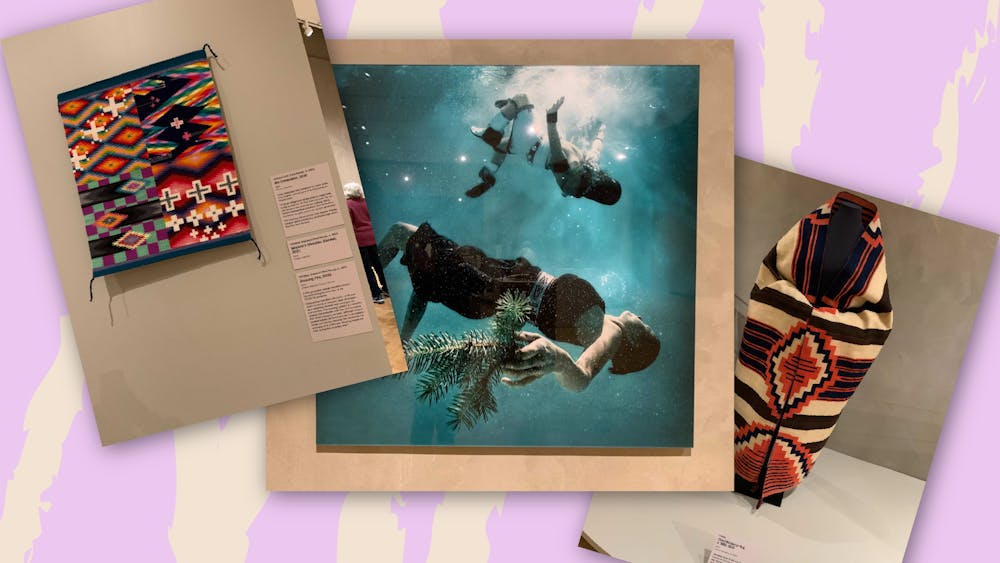“Po–wa–ha (water–wind–breath) is the essence of life. Existence is determined not by a physical body or other physical manifestation but by the breath, which is symbolized by the movement of the water and wind. It is the breath which flows without distinction through the entirety of animate and inanimate existences. … We flow in the Po–wa–ha along with all other manifestations of life.” — Rina Swentzell (Santa Clara Pueblo), 1993
Water, Wind, Breath—the latest special exhibit at the Barnes Foundation—uncovers art made by the Pueblo and Diné (Navajo) communities. It demonstrates how the region’s mountains, valleys, and mesas (now in present–day New Mexico and Arizona) are a reflection of the people establishing harmony and beauty in their craftings. Be it through pottery, weaving, or jewelry, the exhibition illustrates how the Southwestern communities’ underlying cultural values sustained their health and well–being. As Dr. Albert Barnes discovered in his travels, the Native Americans used their art alive in the landscape and ritualistic dances to sprout a deep sense of community and creative energy ridden with their culture.
This exhibition displays these exact histories to illustrate how energy in the Pueblo sphere ebbed and flowed through all the practices that nourished their livelihoods. The textiles, pottery, and jewelry that Barnes’ collection brought together holds works from contemporary Native artists, acting as a testament to their living traditions. As the exhibit quotes, “Now, as always, creating is central to staying well.”

A short ride to the Barnes Foundation allows you a small glimpse into how the topography of Southwestern land has reflected the Pueblo idea that all things have beauty and value, even if the qualities are often hidden or unrecognized. Through the various craftings in this condensed exhibition, you’ll be reminded of the Pueblo characteristics that defined the community for ages. With a piece like the Pin–da–getti (Strong Heart), the Pueblo people initiated that the protagonist is feeling the Earth with her heart, meaning that the stronger one’s connection with Mother Earth, the stronger their heart.
The jewelry displayed at the gallery also has recurring themes of subsuming turquoise to draw inspiration from the mountains and mass of Southwestern landscape. The bracelets and turquoise–accented rings in the glass displays celebrate the enduring relationships the communities held with their land. What’s evidently intriguing is how the Pueblo universe appears on a shell, the sky a mosaic of stones, as seen in the pendant, which centers the wearer in relationship with Pueblo ancestors and supernatural beings. Turquoise and its bifurcated designs, as molded by Zuni Pueblo, recall stories of the watery underworld from which the people emerged. From the historic presentations, the overlapping worldview is evident, that clay and cloth are complementary expressions of prayer to the Pueblo, and that soft, light cotton is also a gift from Father Sun.

Additionally, with pieces like the Great Disaster, visitors to Water, Wind, Breath can clearly read how water holds a primary importance in the physical and spiritual lives of the Pueblo, as it represents a microcosm of the universe. It also underscores how the vision of climate change remains a challenge to overcome, especially currently, be it intertwined through dance or faith—as dances are renewal prayers for the rain—as it parallels the drought and migration of the 13th century, which brought Pueblo ancestors to their current homes along the Rio Grande.

Something to truly ponder as you peruse this exhibit is how such beautiful pieces could be collected despite, or rather, through, the hurdles these Native communities faced. The blankets and textiles are something to be closely studied for their background stories, since in the 19th century, wealthy Spanish and Mexican families captured and enslaved Diné women for their wool–working abilities.
While such realities are difficult to think of, Barnes’ collection lays on a foundation of respect and historical accuracy, making sure to link each craft to the artist and acknowledge how these Southwest Native artisans have kinetically brought the past forward and allowed it to reverberate through their work today. While the room holding these telling artifacts is small, you’re encouraged to take your time with each artwork, to envisage all uncovered tales from the Southwest. The Barnes Foundation is itself situated in the ancestral homeland of the Lenape people, yet is committed to honor Natives’ prevailing relationship to their lands and serve as responsible stewards to it, guided by knowledge. The Water, Wind, Breath exhibition in the Roberts invites visitors to emotionally connect with the Pueblo and Diné homelands and artistic pieces, and to nurture an inclusive and equitable learning space for present and future generations.
The exhibition Water, Wind, Breath: Southwest Native Art in Community will be at the Barnes Foundation through May 15. Student tickets are $5.







